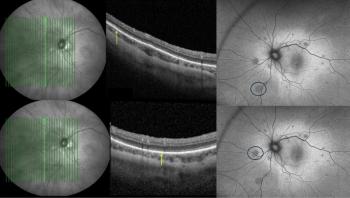
What therapy should we be administering to our DME patients? ANTI-VEGF
The high incidence of side effects associated with steroids makes them a less favourable treatment option.
Key Points
The treatment of diabetic macular oedema (DME) is not straightforward; we have several options available to us, varying from laser treatment and surgery to drug therapy.
Steroid side-effect concerns
Granted, we still have some way to go in the treatment of DME; outcomes are far from perfect and there is still significant room for improvement, both from a surgical and from a therapeutic standpoint. However, if I compare anti-VEGF with steroid therapy, I have to say that the high incidence of side effects associated with steroids makes them a less favourable treatment option.
What evidence do we have?
Anti-VEGF therapy as a treatment for DME is still investigational. The rationale for its use, however, is convincing; studies have shown increased levels of VEGF in the aqueous humour of DME patients,1,2 while separately it has been shown that blood-retinal-barrier breakdown in diabetics is, in fact, VEGF-dependent.3 Hence, VEGF inhibition seems to be a feasible treatment option for diabetic patients.
Although laser photocoagulation is the current gold standard, it is still suboptimal; vision loss is not reversed and the risk of vision loss is only reduced, not eliminated. I do opt to treat the majority of my DME patients with laser photocoagulation in the first instance but, if the oedema is diffuse and there is chronicity without stabilization, this is followed by intravitreal steroid or anti-VEGF treatment. I follow this again with laser treatment for stabilization.
I still do not have enough evidence to make a confident and well-informed choice between steroids and anti-VEGF treatment, but the improved visual acuity outcomes and the lack of advanced retinal ischaemia, coupled with the lower incidence of side effects with anti-VEGF therapy, all lead me to believe that this is the best therapeutic option available to us. Approximately 50% of my DME patients respond positively to anti-VEGF therapy and, although it has been difficult to gather concrete data on the efficacy of this kind of treatment, my patients have been generally satisfied.
I am also encouraged by recent studies, which have shown efficacy of the anti-VEGF agents pegaptanib and ranibizumab in the diabetic population. For example, ranibizumab, in the RESOLVE trial (a Phase I/II European study) showed an improvement in visual acuity and a decrease in central macular thickness in DME patients.4 A Phase III trial is now underway to assess its safety and efficacy as monotherapy and as an adjunct therapy to laser photocoagulation.5
The future of DME treatment lies with combination strategies
Ultimately, I believe in the potential of combining different modes of action to bring about an enhanced effect. Currently, I employ a combination treatment strategy through the use of laser and drug treatment in my DME patients. Perhaps there will be room, in the future, for combined steroid and anti-VEGF therapy; however, we are still very much in a period of learning. We must first define the inflammatory and ischaemic reactions of the retina to these therapies before we can appropriately modulate our treatment strategy. We must also not forget the important role that systemic diabetes and hypertension treatment plays in these patients.
To make steroid therapy a more attractive option to me, I really would need to see evidence of fewer side effects. If a steroid implant, which had a clear pharmacokinetic profile, were made widely available, this would be ideal.
In the future, I believe that we will be initiating treatment in the earlier stages of oedema and before visual acuity deteriorates. This treatment may be local or systemic but it will not necessarily involve repeated intravitreal injections. I also believe that the treatment of advanced DME cases will involve combination therapeutics, with or without laser treatment.
---
To read Professor Francesco Bandello's counter-argument, please go to
---
References
1. L.P. Aiello, et al. N. Engl. J. Med. 1994;33(22):1480–1487.
2. H. Funatsu, et al. Ophthalmology 2003;110(9):1690–1696.
3. T. Qaun, et al. Invest. Ophthalmol. Vis. Sci. 2001;42:2408–2413.
4. P.G. Massin. New Horizons: latest clinical developments with Lucentis. Paper presented at the Euretina annual congress, 23 May 2008; Vienna, Austria.
5.
Newsletter
Get the essential updates shaping the future of pharma manufacturing and compliance—subscribe today to Pharmaceutical Technology and never miss a breakthrough.













































